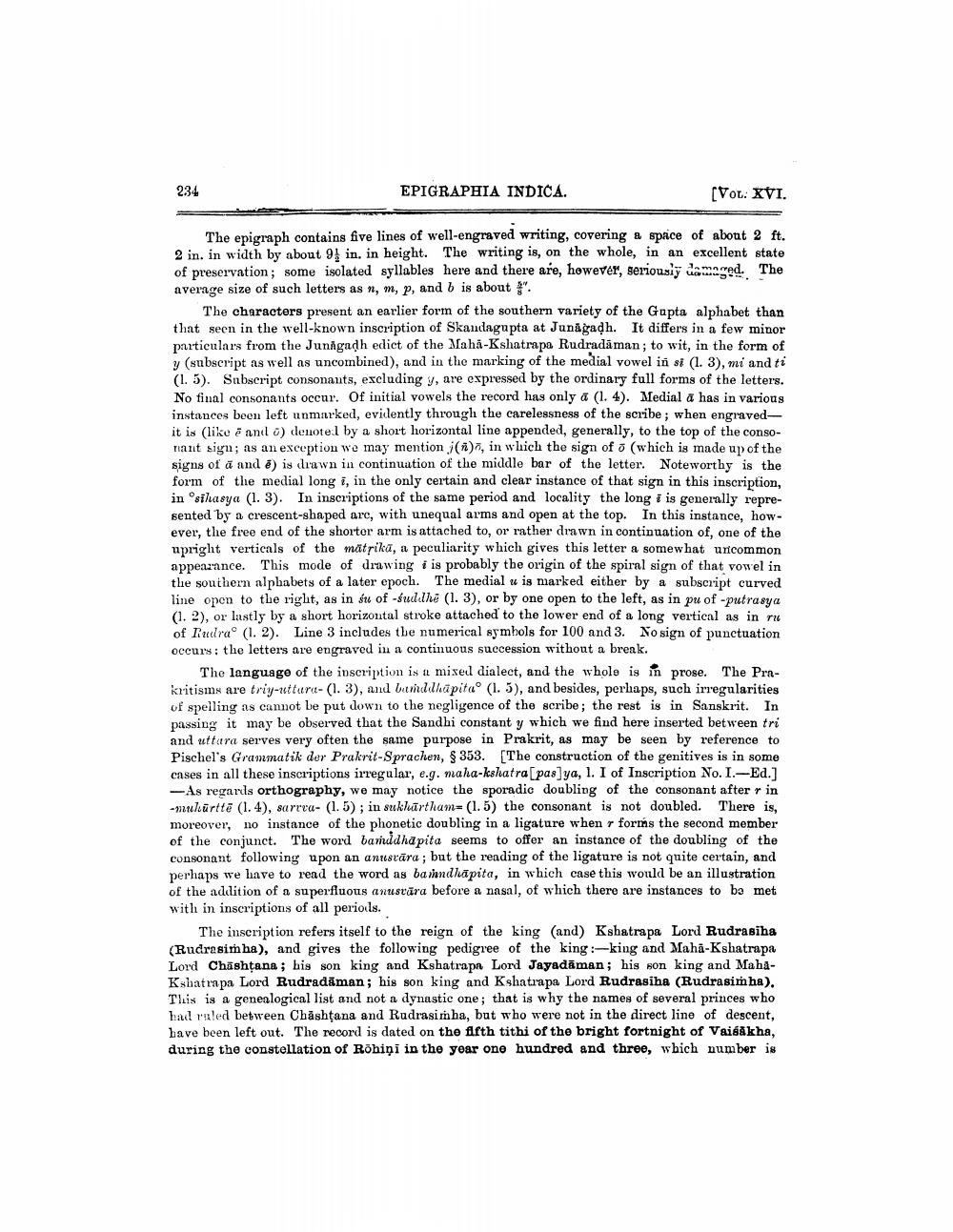________________
234
EPIGRAPHIA INDICA.
(VOL: XVI.
The epigraph contains five lines of well-engraved writing, covering a space of about 2 ft. 2 in. in width by about 94 in, in height. The writing is, on the whole, in an excellent state of preservation; some isolated syllables here and there are, however, seriously damaged. The average size of such letters as n, m, p, and b is about $".
The characters present an earlier form of the southern variety of the Gupta alphabet than that seen in the well-known inscription of Skandagupta at Junagadh. It differs in a few minor particulars from the Junagadh edict of the Maha-Kshatrapa Rudradāman; to wit, in the form of y (subscript as well as uncombined), and in the marking of the medial vowel in si (1.3), mi and ti (1. 5). Subscript consonants, excluding y, are expressed by the ordinary full forms of the letters. No final consonants occur. Of initial vowels the record has only a (1.4). Medial a has in various instances been left unmarked, evidently through the carelessness of the scribe; when engravedit is (like e anilo) denotel by a short horizontal line appended, generally, to the top of the consonant sign; as an exception we may mention ii), in which the sign of o (which is made up of the signs of ū and ē) is drawn in continuation of the middle bar of the letter. Noteworthy is the form of the medial long i, in the only certain and clear instance of that sign in this inscription, in silasya (1. 3). In inscriptions of the same period and locality the long x is generally represented by a crescent-shaped are, with unequal arms and open at the top. In this instance, however, the free end of the shorter arm is attached to, or rather drawn in continuation of, one of the upright verticals of the mätsika, a peculiarity which gives this letter a somewhat uricommon appearance. This mode of drawing i is probably the origin of the spiral sign of that vowel in the southern alphabets of a later epoch. The medial u is marked either by a subscript curved line open to the right, as in ste of -sudlhé (1. 3), or by one open to the left, as in pu of -putrasya (1.2), or lastly by a short horizontal stroke attached to the lower end of a long vertical as in ru of Tiradrao (1.2). Line 3 includes the numerical symbols for 100 and 3. No sign of punctuation occurs: the letters are engraved in a continuous succession without a break.
The language of the inscription is a mixed dialect, and the whole is in prose. The Prakritisms are try-uitur- (1.3), and burdlhūpitao (1.5), and besides, perhaps, such irregularities of spelling as cannot be put down to the negligence of the scribe; the rest is in Sanskrit. In passing it may be observed that the Sandhi constant y which we find here inserted between tri and uttara serves very often the same purpose in Prakrit, as may be seen by reference to Pischel's Grammatik der Prakrit-Sprachen, $ 353. [The construction of the genitives is in some cases in all these inscriptions irregular, e.g. maha-kshatra pas]ya, 1. I of Inscription No. 1.-Ed.] -As regards orthography, we may notice the sporadic doubling of the consonant after r in -mulürttē (1.4), sarrva- (1.5); in sukhārtham= (1.5) the consonant is not doubled. There is, moreover, no instance of the phonetic doubling in a ligature when r forms the second member of the conjunct. The word barddhapita seems to offer an instance of the doubling of the consonant following upon an antietāra ; but the reading of the ligature is not quite certain, and perhaps we have to read the word as barndhāpita, in which case this would be an illustration of the addition of a superfluous anustūra before a nasal, of which there are instances to be met with in inscriptions of all periods.
The inscription refers itself to the reign of the king (and) Kshatrapa Lord Rudrabiha (Rudresimha), and gives the following pedigree of the king :-king and Maha-Kshatrapa Lord Chashtana; his son king and Kshatrapa Lord Jayadāman; his son king and MahaKshatrapa Lord Rudradāman; his son king and Kshatrapa Lord Rudrasiha (Rudrasimha). This is a genealogical list and not a dynastic one; that is why the names of several princes who had ruled between Chashtana and Rudrasimha, but who were not in the direct line of descent, have been left out. The record is dated on the fifth tithi of the bright fortnight of Vaisakha, during the constellation of Rohiņi in the year one hundred and three, which number is




